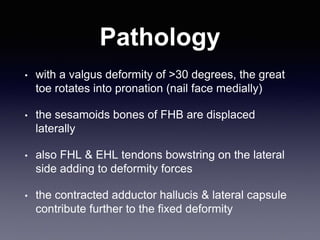Final hallux valgus pp
- 1. Hallux Valgus Dr. E. M. Regis Jr. Orthopaedic Dept. S.G.P.H 16/5/16
- 2. Overview âĒ History âĒ Definition âĒ Incidence âĒ Aetiology âĒ Anatomy âĒ Pathology âĒ Signs/ Symptoms âĒ Investigation âĒ Diagnosis âĒ Treatment âĒ Conclusion
- 3. History âĒ âHallux Valgus" was define as static subluxation of first Metatarsophalangeal Joint with lateral deviation of great toe. âĒ This term was introduced by Carl Hueterto. âĒ The first surgical procedure to address the deformity was described by Reverdin in May, 1881.
- 4. Definition âĒ deformity resembling abduction contracture in which great toe turned away from mid-line of body. âĒ commonly referred to as âBunionâ
- 5. Lateral deviation of Great Toe Medial deviation of 1st Metatarsal Progressive subluxation of 1st MTP joint
- 6. Incidence âĒ 1% adults in US Gould et al studies âĒ increased incidence with age (3% 15-30 yrs, 9% 31-60 yrs & 16% >60yrs) âĒ F > M {2:1 - 4:1}
- 7. Aetiology âĒ Extrinsic Factors; shoes with narrow toe/ high heels occupational factors
- 8. âĒ Intrinsic Factors; Hereditary {60-90%} Arthritic/metabolic âĒ Gouty arthritis, RA, Connective tissue disorders {Marfan, Ehlers- Danlos, Down} Neuromuscular Disease âĒ Cerebral Palsy, Multiple sclerosis
- 9. Traumatic Conditions âĒ malunions, Dislocations, Intra-articular damage Structural Deformities âĒ malalignment of articular surface, abnormal metatarsal length
- 10. Anatomy Groups Encircling 1st MTP joint 1. Extensor hallucis longus & brevis 2. Flexor hallucis longus & brevis 3. Abductor 4. Adductor
- 11. Pathology âĒ with a valgus deformity of >30 degrees, the great toe rotates into pronation (nail face medially) âĒ the sesamoids bones of FHB are displaced laterally âĒ also FHL & EHL tendons bowstring on the lateral side adding to deformity forces âĒ the contracted adductor hallucis & lateral capsule contribute further to the fixed deformity
- 13. Signs/Symptoms âĒ Asymptomatic âĒ Pain/ Tenderness âĒ Skin calluses/ areas of redness âĒ Increased/Decreased 1st MTP joint R.O.M âĒ Pronation of great toe
- 15. Investigation âĒ Radiographs weight bearing AP, lateral & oblique views Findings; lateral displacement of sesamoids joint congruency & degenerative changes
- 16. âĒ Hallux Valgus Angle (HVA) intersection of longitudinal axis of 1st MT and proximal phalanx (normal <15)
- 17. âĒ Intermetatrsal Angle (IMA) Intersection of 1st & 2nd MT (Normal <9)
- 20. Classification Piggott (1960) based on x ray appearance 1. MTP joint is centred but the articular surfaces though congruent, are tilted towards valgus 2. articular surfaces are not congruent, the phalangeal surface being tilted towards valgus 3. the joint is both incongruent and slightly subluxated
- 22. âĒ Labs Uric acid ESR C-reactive protein ANA RF
- 23. Diagnosis Root et al (pathomechanical devlopment of hallux valgus) âĒ Stage 1 - excessive pronation causes hypermobility of 1st ray, causing the tibial sesamoid ligament to be stretched and the fibular sesamoid ligament to contract; lateral subluxation of the proximal phalanx occurs âĒ Stage 2 - hallux abduction progresses, with the flexor hallucis longus and flexor hallucis brevis gaining lateral mechanical advantage
- 24. âĒ Stage 3 - Further subluxation occurs at the 1st MTP joint, with formation of metatarsus primus adductus âĒ Stage 4 - The 1st MTP joint finally dislocates
- 25. Treatment Medical cannot change the irreversible cartilage, bony & soft tissue adaptions of the deformity âĒ Adapting footwear - shoes with wider & deeper toe box. Extra padding & strapping
- 26. âĒ Pharmacologic/ Physical Therapy - NSAIDS in acute episodic inflammatory process. No evidence to support prolong physical therapy. âĒ Functional orthotic therapy
- 27. Surgical Indications; persistent pain (not cosmetic) progression of deformity failure of non operative treatment Goals; correct all pathologic elements and maintain biomechanically functional forefoot. Combination of soft tissue procedures with bony procedures in almost all cases
- 28. âĒ SOFT TISSUE PROCEDURES NB. Medial & Lateral procedures done together are contraindicated
- 30. âĒ BONY PROCEDURE Distal MT: {IM angle 12-15 degrees) Mitchell Wilson Chevron Proximal MT: {IM angle >15 degrees} Medial opening wedge Lateral closing wedge
- 31. Mitchell Chevron
- 32. Phalangeal: Proximal Phalanx Osteotomy {Aiken} Combination osteotomies Kellerâs excision for arthritis of MTP joint Arthrodesis .. {eg. Lapidus)
- 36. Complications âĒ Recurrent deformity âĒ Hallux Varus âĒ Pronation deformity âĒ Pain âĒ Neurologic Injury âĒ Osteonecrosis âĒ Nonunion/ malunion
- 37. Conclusion âĒ Hallux Valgus is abduction contracture deformity resembling big toe displaced laterally. âĒ Women have a higher incidence which is directly proportional with increase age. âĒ Aetiology is divided into extrinsic & intrinsic factors. âĒ Treatment usually non surgical first, then if failed surgical option is advised. âĒ Surgery most often involves a combination of soft tissue and bony procedures.
- 38. References âĒ Apleyâs System of Orthopaedics & Fracture, 9th Edition âĒ Campbellâs Operative Orthopaedics: 12th Edition, Vol.1 âĒ J Maheshwari (1997), Essential Orthopaedics 2nd Edn. New Delhi, Interprint âĒ www.orthobullets.com/halluxvalgus






































